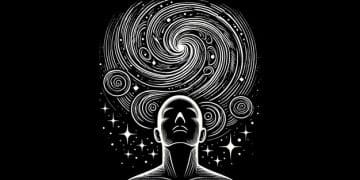Cognitive Behavioral Therapy: Overcome Negative Thought Patterns

Cognitive Behavioral Therapy (CBT) offers a structured and effective approach to help individuals identify, challenge, and change unhelpful thinking patterns and behaviors that contribute to emotional distress, fostering healthier coping mechanisms and improved well-being.
Life’s complexities often lead us down paths riddled with negative thoughts, creating emotional turbulence that can feel overwhelming. These ingrained patterns, whether conscious or subconscious, frequently dictate our responses to situations, impacting our mental well-being and overall quality of life. Understanding How Cognitive Behavioral Therapy (CBT) Can Help You Overcome Negative Thought Patterns is a crucial step towards reclaiming control over your internal landscape and fostering a more adaptive mindset.
Understanding the Core Principles of CBT
Cognitive Behavioral Therapy, commonly known as CBT, isn’t just another form of talk therapy; it’s a highly structured and evidence-based psycho-social intervention. At its heart, CBT operates on the fundamental premise that our thoughts, feelings, and behaviors are interconnected. This means that changing one element can profoundly influence the others. For someone grappling with persistent negative thought patterns, this offers a tangible pathway to change, rather than simply discussing past events. The focus is on the present, identifying current challenges and developing practical strategies.
The beauty of CBT lies in its collaborative nature. It’s not about the therapist “fixing” the client, but rather empowering the individual to become their own therapist. Through guided exercises and homework assignments, clients learn to recognize their cognitive distortions – irrational or biased ways of thinking that perpetuate negative feelings. This active participation is key to the lasting effects of CBT, as it equips individuals with tools they can use long after therapy concludes.
The Cognitive Distortions We All Face
Before one can challenge negative thoughts, it’s essential to understand their common manifestations. These are often referred to as cognitive distortions, and they are surprisingly prevalent in everyday thinking. Identifying these distortions is the first critical step in dismantling their power over our emotional responses.
- Catastrophizing: Believing that future events will always be negative and disastrous.
- All-or-Nothing Thinking: Seeing things in absolute terms, with no middle ground.
- Overgeneralization: Drawing broad, sweeping conclusions from a single event.
- Mental Filtering: Focusing only on the negative aspects of a situation, ignoring the positives.
- Personalization: Taking responsibility for events that are outside one’s control.
By learning to spot these patterns, individuals begin to create a critical distance from their thoughts, realizing that a thought is not necessarily a fact. This awareness is foundational; without it, the cycle of negative thinking can continue unchecked, reinforcing self-defeating beliefs and behaviors that limit personal growth and happiness.
Ultimately, the goal in this initial phase of CBT is not to eliminate all negative thoughts, which would be unrealistic, but to develop a healthier relationship with them. It’s about learning to assess the validity of thoughts, challenge those that are unhelpful or irrational, and replace them with more balanced and realistic perspectives. This process demands commitment and consistent effort, but the rewards in terms of improved mental clarity and emotional regulation are substantial, leading to a profound transformation in daily living.
Identifying and Challenging Negative Thought Patterns
Once the basic principles of CBT are grasped, the practical work of identifying and challenging negative thought patterns begins. This process is deeply personal, as negative thoughts manifest differently for everyone. The core objective is to move beyond simply observing these thoughts to actively engaging with them, questioning their validity and considering alternative interpretations. This active engagement is what separates CBT from other therapeutic approaches, making it a dynamic and empowering experience for many.
A central technique used in CBT is thought record keeping. This involves systematically documenting specific situations, the thoughts that arise, the emotions experienced, and the resulting behaviors. This detailed record serves as concrete evidence, allowing individuals to objectively examine their thought processes rather than relying on abstract feelings. It’s akin to becoming a detective of your own mind, gathering clues to understand the patterns that have been influencing your emotional state.
The Thought Interrogation Process
After identifying a negative thought, the next step involves a rigorous, yet compassionate, interrogation. This isn’t about shaming oneself for having certain thoughts but rather about seeking clarity and accuracy. The therapist guides the client through a series of probing questions designed to expose the flaws in irrational thinking. This systematic questioning helps to dismantle the belief that a thought is an infallible truth.
- What is the evidence for this thought?
- What is the evidence against this thought?
- Is there an alternative explanation for this situation?
- What would I tell a friend in this same situation?
- Is this thought helpful or unhelpful for my goals?
This “thought challenging” phase is arguably the most transformative part of CBT. It moves individuals from passive acceptance of their negative thoughts to active disputation. By consistently challenging these internal narratives, the brain begins to form new neural pathways, making it easier to naturally adopt more balanced and realistic perspectives over time. It requires practice and persistence, but each successful challenge weakens the grip of negative patterns.
Furthermore, this process isn’t just intellectual; it often involves behavioral experiments. If someone believes they will fail at a new task, a behavioral experiment might involve them trying the task anyway, perhaps in a smaller, controlled way. The outcome, whether success or partial success, provides experiential evidence that directly contradicts the negative prediction, reinforcing the idea that thoughts are not always accurate reflections of reality. This blend of cognitive and behavioral strategies is what makes CBT so comprehensive and effective.
Behavioral Activation and Experiential Learning
CBT isn’t solely about changing thoughts; it also heavily emphasizes changing behaviors. Behavioral activation is a key component, especially for individuals experiencing depression or anxiety, where inactivity or avoidance can perpetuate negative cycles. This part of the therapy encourages individuals to engage in activities that are either pleasurable or mastery-oriented, regardless of their current mood. The premise is simple: action can lead to changes in mood and thought, reversing the cycle of withdrawal and negativity.
For someone caught in a negative thought loop, it’s common to avoid situations where those thoughts might be triggered. However, avoidance, while offering temporary relief, paradoxically strengthens the negative pattern in the long run. Behavioral activation asks individuals to gently push back against this urge. This could mean scheduling social interactions, pursuing hobbies, or tackling previously daunting tasks. The aim is to gather new experiences that challenge preconceived negative notions about oneself or the world. This approach highlights that our actions are just as powerful as our thoughts in shaping our emotional landscape.

Systematic Desensitization and Exposure Therapy
Beyond general behavioral activation, CBT often incorporates specialized behavioral techniques like systematic desensitization and exposure therapy, particularly valuable for specific anxieties or phobias. Systematic desensitization involves gradually exposing an individual to anxiety-provoking situations or objects, starting with the least threatening and moving towards the most. This is often paired with relaxation techniques, helping the individual to associate the previously feared stimulus with a sense of calm.
Exposure therapy extends this by directly confronting feared situations, often in vivo (in real life), to demonstrate that the feared outcome is unlikely or manageable. For example, someone with social anxiety might gradually expose themselves to social gatherings, starting with a brief interaction and slowly increasing the duration and complexity. The core idea is to break the avoidance cycle and allow the individual to learn through direct experience that their anxiety is manageable and often disproportionate to the actual threat.
- Gradual exposure to feared situations.
- Learning to tolerate discomfort and anxiety.
- Challenging avoidance behaviors head-on.
- Developing new coping skills in real-time scenarios.
- Experiencing firsthand that feared outcomes rarely materialize.
This experiential learning is profoundly impactful because it bypasses purely intellectual understanding. It’s one thing to rationally know a fear is irrational; it’s another to experience that realization in a real-world context. The success stories from these techniques are powerful testimonies to the efficacy of not just thinking differently, but also acting differently. By combining cognitive restructuring with precise behavioral interventions, CBT offers a holistic pathway to breaking free from limiting negative patterns.
Addressing Underlying Beliefs and Schemas
While challenging individual negative thoughts is crucial, CBT also delves deeper to address the underlying core beliefs and schemas that often give rise to these patterns. Core beliefs are fundamental assumptions we hold about ourselves, others, and the world. These are often developed early in life through experiences and can be intensely powerful, even if they aren’t always conscious. When these core beliefs are negative or distorted, they act as a filter through which we interpret all new information, perpetually reinforcing negative thought patterns.
For example, a core belief might be “I am unlovable” or “I am incompetent.” If someone holds the belief “I am incompetent,” every minor mistake might be interpreted as definitive proof, confirming their deep-seated conviction. This then triggers a cascade of negative thoughts (“I’ll never succeed,” “Everyone knows I’m a failure”), even if objective evidence contradicts this belief. Addressing these schemas involves a more extensive therapeutic process, often using techniques like Socratic questioning to explore the origins and validity of these deep-seated convictions.
Schema Therapy and Its Role
In more complex cases, especially for individuals with chronic or pervasive negative patterns, a more specialized form of CBT known as Schema Therapy might be employed. Developed by Dr. Jeffrey Young, Schema Therapy integrates elements of CBT, attachment theory, and psychodynamic concepts to address these deeper, more enduring patterns, or “early maladaptive schemas.” These schemas are broader, pervasive themes or patterns comprised of memories, emotions, cognitions, and bodily sensations, regarding oneself and one’s relationships with others.
Schema Therapy aims to identify these entrenched schemas and then provide corrective emotional experiences, helping individuals to bypass their typical coping styles (surrender, avoidance, overcompensation) and directly address the unmet needs that fueled the schema’s development. This can involve limited reparenting (where the therapist provides what the original caregivers could not) and experiential techniques, moving beyond purely cognitive restructuring to a more profound level of emotional healing and integration.
- Identify core beliefs and their origins.
- Understand how schemas influence current thought patterns.
- Develop healthier, more adaptive core beliefs.
- Engage in strategies to “heal” early maladaptive schemas.
- Promote emotional awareness and self-compassion.
The work on core beliefs and schemas is often a longer-term endeavor within CBT, moving beyond symptomatic relief to more fundamental personality change. It’s about building a solid psychological foundation, equipping individuals with a resilient internal framework from which to view themselves and the world. By reshaping these foundational beliefs, the likelihood of relapse into old negative patterns significantly decreases, leading to more sustained and profound mental wellness. This journey requires patience and persistence, but the insights gained can be life-changing.
The Role of Mindfulness and Acceptance in CBT
While traditional CBT focuses on challenging and changing thoughts, modern applications increasingly integrate elements of mindfulness and acceptance. This isn’t a contradiction but rather an evolution, recognizing that some thoughts, especially intrusive or distressing ones, may not always be entirely preventable or immediately changeable. The goal shifts from eradication to a more skillful relationship with one’s internal experiences. This nuanced approach adds a layer of flexibility and self-compassion to the CBT framework, making it even more robust.
Mindfulness, in the context of CBT, involves paying attention to the present moment without judgment. When applied to negative thoughts, this means observing them as they arise, acknowledging their presence, but choosing not to engage with them. Instead of trying to argue with a thought or push it away, one simply notices it, understanding that thoughts are transient mental events, not necessarily facts or commands. This creates a psychological space between the individual and their thought, diminishing its power and emotional impact.

Acceptance and Commitment Therapy (ACT) Principles
An offshoot, or “third wave,” of CBT, Acceptance and Commitment Therapy (ACT), places even greater emphasis on acceptance. ACT posits that attempting to control or eliminate uncomfortable thoughts and feelings can be counterproductive, often leading to more distress. Instead, ACT encourages psychological flexibility, which involves embracing rather than fighting one’s thoughts and feelings, and committing to actions that align with one’s values, regardless of these internal experiences.
Key principles of ACT include cognitive defusion (learning to see thoughts as just thoughts, not facts), acceptance (making room for painful feelings), and values clarification (identifying what truly matters). By focusing on living a rich and meaningful life even in the presence of distress, ACT offers a powerful complement to traditional CBT techniques. It’s about realizing that one can have negative thoughts and still move forward in a direction that is personally significant. This integration expands the toolkit available to individuals struggling with persistent negative thought patterns, offering more pathways to psychological freedom.
- Observe thoughts without judgment.
- Practice non-attachment to internal experiences.
- Develop psychological flexibility.
- Identify and pursue personal values.
- Embrace discomfort as part of the human experience.
The synergy between classic CBT, mindfulness, and acceptance principles creates a comprehensive approach to mental wellness. While CBT provides the tools to challenge unhelpful thoughts, mindfulness and acceptance offer a way to navigate the thoughts that remain, fostering a more peaceful and adaptable inner state. This dual approach ensures that individuals are well-equipped to manage the full spectrum of their internal experiences, leading to greater resilience and emotional balance in the long run.
Building Resilience and Preventing Relapse
Overcoming negative thought patterns isn’t just about managing immediate distress; it’s also about building long-term resilience and developing strategies to prevent relapse. CBT is inherently geared towards empowering individuals to become their own therapists, providing them with a robust toolkit of skills that extend far beyond the therapy room. The ultimate goal is to equip individuals to sustain their progress and navigate future challenges independently, transforming temporary relief into lasting well-being.
A crucial aspect of relapse prevention in CBT involves recognizing early warning signs. Just as a fire alarm signals danger, certain thoughts, emotions, or behaviors can indicate a potential return to old patterns. By learning to identify these triggers and initial dips in mood or thinking, individuals can proactively apply the coping strategies learned in therapy before a full-blown relapse occurs. This self-awareness is a cornerstone of sustained mental health, turning potential setbacks into opportunities for practice and reinforcement.
Developing a Wellness Maintenance Plan
To solidify the gains made in therapy, a personalized wellness maintenance plan is often developed in the later stages of CBT. This plan outlines specific strategies and resources individuals can draw upon when facing stress or the resurgence of negative thoughts. It’s a proactive roadmap for continued mental wellness, ensuring that the skills acquired are regularly practiced and refined. The plan acts as a reminder of progress made and a guide for future self-care, reinforcing the individual’s commitment to their ongoing mental health journey.
- Regular practice of cognitive restructuring techniques.
- Scheduled behavioral activation activities.
- Mindfulness exercises for daily stress management.
- Identifying and utilizing support systems (friends, family, support groups).
- Planning for potential setbacks and creating coping strategies.
Perhaps one of the most powerful aspects of CBT for relapse prevention is the emphasis on self-compassion. The journey to overcome negative thought patterns is rarely linear; there will be moments of struggle and perhaps even temporary regressions. Learning to treat oneself with kindness and understanding during these times, rather than resorting to self-criticism, is vital. This acceptance of imperfection fosters resilience, allowing individuals to view setbacks as learning opportunities rather than failures. It’s about cultivating an internal environment of support, ensuring that the progress made is not only maintained but continuously built upon.
By integrating all these elements – skill reinforcement, early warning sign recognition, a robust maintenance plan, and a compassionate self-approach – CBT provides a comprehensive framework for not just overcoming negative thought patterns but fostering a resilient and flourishing mindset for life. This ongoing commitment to self-care and skill application is what truly enables lasting change and an enhanced quality of life.
Integration of CBT into Daily Life
The true measure of successful therapy lies in its applicability to daily life. CBT is not just about sessions with a therapist; it’s about integrating the learned skills and insights into every interaction, every decision, and every self-reflection. This continuous application is what transforms theoretical knowledge into practical wisdom, making the principles of CBT an organic part of one’s operating system. It moves beyond a temporary fix to a sustainable way of living, fostering mental agility and emotional balance in real-time scenarios.
This integration often involves subtle shifts in perspective and routine. For instance, rather than immediately reacting to a challenging situation with a habitual negative thought, an individual might pause, consciously identify the distortion, and then actively reframe it. This doesn’t happen overnight, but with consistent practice, these deliberate actions become more automatic, slowly replacing old, unhelpful patterns with healthier, more adaptive ones. Regular self-monitoring, even informally, can significantly aid this process.
Building New Habits and Routines
To embed CBT principles effectively, creating new habits and routines is essential. This can be as simple as dedicating a few minutes each day to practicing mindfulness, reviewing thought records, or consciously engaging in activities that bring a sense of accomplishment or pleasure. These small, consistent efforts compound over time, building a robust psychological foundation. The routine acts as a framework, providing structure and reducing the cognitive load needed to implement the new strategies.
- Daily check-ins for automatic negative thoughts (ANTs).
- Scheduled “worry time” to contain anxious thoughts.
- Regular exercise and healthy eating for mood regulation.
- Mindful pauses throughout the day to re-center.
- Practicing gratitude to shift focus to positive aspects.
Moreover, integrating CBT means extending its principles to interpersonal relationships. By understanding how our own thoughts influence our reactions to others, we can communicate more effectively, reduce misunderstandings, and build stronger connections. This might involve challenging assumptions about others’ intentions or practicing empathy, allowing for more balanced and constructive interactions. The insights gained from CBT offer a lens through which to better understand both oneself and the social world, leading to more fulfilling relationships.
Ultimately, the integration of CBT into daily life signifies a profound shift from being a passive recipient of thoughts and emotions to becoming an active architect of one’s mental experience. It’s about cultivating a proactive stance towards mental well-being, recognizing that while external events may be uncontrollable, our internal responses are largely within our power to shape. This empowers individuals to live with greater intention, resilience, and a deeper sense of inner peace, transforming challenges into opportunities for growth.
Limitations and When to Seek Professional Guidance
While Cognitive Behavioral Therapy is widely recognized as a highly effective intervention for a spectrum of mental health challenges, it’s important to acknowledge its limitations and understand when professional guidance is not just beneficial, but essential. CBT is a powerful tool, but it’s not a panacea, nor is it universally suited for everyone. Recognizing these boundaries ensures that individuals receive the most appropriate and comprehensive care for their unique circumstances, maximizing the chances of successful outcomes.
One primary limitation is the cognitive demand it places on individuals. CBT requires a certain level of introspection, a willingness to engage with one’s thoughts, and the capacity for abstract reasoning. For individuals experiencing severe cognitive impairment, acute psychosis, or profound intellectual disabilities, the standard format of CBT may be challenging to implement effectively. In such cases, modified CBT approaches or alternative therapeutic modalities might be more suitable, tailored to the individual’s specific needs and capabilities.
When CBT Alone May Not Be Enough
There are also instances where negative thought patterns are deeply entrenched or arise from complex traumatic experiences that require more than cognitive restructuring alone. While CBT can provide coping mechanisms for trauma-related symptoms, it might not fully address the underlying emotional processing required for comprehensive healing. In such scenarios, therapies like Eye Movement Desensitization and Reprocessing (EMDR), Dialectical Behavior Therapy (DBT), or psychodynamic approaches might be integrated or prioritized to offer a more holistic treatment.
Moreover, CBT is not a substitute for pharmacological interventions when medication is clinically indicated for severe mental health conditions like major depressive disorder with psychotic features, bipolar disorder, or severe obsessive-compulsive disorder. In many cases, a combination of medication and CBT proves to be the most effective strategy, where medication helps to stabilize symptoms, creating a better foundation for the therapeutic work to take hold. This integrated approach leverages the strengths of both modalities, offering a more robust path to recovery.
- Severe or persistent symptoms requiring medical evaluation.
- Presence of co-occurring disorders (e.g., substance use, eating disorders).
- Complex trauma that needs specialized processing.
- Lack of motivation or capacity to engage in CBT exercises.
- When self-help CBT resources are insufficient for desired change.
The availability of highly trained and regulated CBT therapists is also a crucial factor. While many self-help books and online resources exist, the nuanced application of CBT techniques, the ability to tailor strategies to individual needs, and the empathetic guidance of a qualified professional are invaluable. Attempting to self-administer CBT for complex issues without proper guidance can lead to frustration or incomplete understanding, potentially delaying effective treatment. Therefore, if negative thought patterns are significantly impairing daily functioning, causing severe distress, or persisting despite self-help efforts, seeking consultation from a licensed mental health professional specializing in CBT is the most advisable course of action.
| Key CBT Principle | Brief Description |
|---|---|
| 🧠 Thought Challenging | Learning to question and reframe unhelpful cognitive distortions. |
| 🏃 Behavioral Activation | Engaging in activities to improve mood and challenge avoidance. |
| 🧘♀️ Mindfulness & Acceptance | Observing thoughts without judgment and embracing psychological flexibility. |
| 🛡️ Relapse Prevention | Developing strategies to maintain gains and manage future challenges. |
Frequently Asked Questions About CBT
The primary goal of CBT is to help individuals identify and change unhelpful thinking patterns (cognitions) and behaviors that contribute to emotional difficulties. By learning to challenge cognitive distortions and engage in more adaptive behaviors, clients can reduce distress and improve their overall well-being, gaining practical skills for long-term emotional regulation and mental health.
The duration of CBT varies depending on the individual and the complexity of the issues, but it is generally considered a short-term therapy. Many individuals experience significant improvements within 12 to 20 sessions, often lasting for 3 to 6 months. Some may require fewer sessions for specific problems, while more entrenched issues might benefit from longer-term engagement.
CBT is highly effective for a wide range of conditions, including depression, anxiety disorders, phobias, PTSD, and OCD. However, its effectiveness can vary. For severe or complex conditions, it might be used in conjunction with other therapies or medication. Some individuals may also find other therapeutic approaches more aligned with their personal needs or learning styles.
While self-help CBT resources like books and apps can be beneficial for mild issues or as a supplementary tool, they are generally not a substitute for professional therapy. A qualified therapist provides personalized guidance, identifies specific cognitive distortions, and helps navigate complex emotions. For significant mental health challenges, professional guidance ensures safety and efficacy.
Cognitive defusion is a technique, particularly emphasized in acceptance and commitment therapy (ACT), that teaches individuals to observe their thoughts without being caught up in them. It’s about seeing thoughts as separate from yourself, not as literal truths or commands. This helps reduce the power of negative thoughts by creating distance, allowing you to choose how to respond rather than being driven by them.
Conclusion
The journey to overcoming negative thought patterns is a profound commitment to personal growth and mental well-being. Cognitive Behavioral Therapy offers a beacon of hope and a practical roadmap for this journey. By systematically teaching individuals to identify, challenge, and ultimately transform their unhelpful thinking patterns and behaviors, CBT provides not just temporary relief but a sustainable framework for psychological resilience. The skills acquired – from cognitive restructuring and behavioral activation to mindfulness and relapse prevention – empower individuals to become active architects of their inner lives. Embracing CBT is an investment in a future where thoughts serve as guides rather than shackles, leading to a life lived with greater clarity, emotional balance, and unwavering purpose. It’s a testament to the power of targeted, evidence-based self-transformation.





